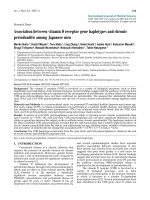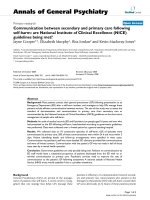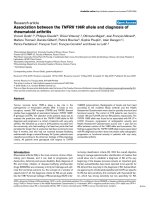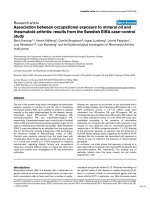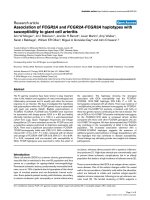Báo cáo y học: "Association between antipsychotics and weight gain among psychiatric outpatients in Pakistan: a retrospective cohort study" ppsx
Bạn đang xem bản rút gọn của tài liệu. Xem và tải ngay bản đầy đủ của tài liệu tại đây (202.89 KB, 4 trang )
BioMed Central
Page 1 of 4
(page number not for citation purposes)
Annals of General Psychiatry
Open Access
Primary research
Association between antipsychotics and weight gain among
psychiatric outpatients in Pakistan: a retrospective cohort study
Syed Ahmer*
1
, Rashid AM Khan
1
and Saleem Perwaiz Iqbal
2
Address:
1
Department of Psychiatry, Aga Khan University, Karachi, Pakistan and
2
Department of Paediatrics & Child Health, Aga Khan University,
Karachi, Pakistan
Email: Syed Ahmer* - ; Rashid AM Khan - ; Saleem Perwaiz Iqbal -
* Corresponding author
Abstract
Background: It has been known for a long time that use of antipsychotics, particularly atypical
antipsychotics, is associated with weight gain and increase in risk of metabolic disturbances. In this
study we have tried to find out if use of antipsychotics is associated with increase in weight and
body mass index (BMI) in the Pakistani population.
Methods: We performed a case note review of all patients who had been prescribed antipsychotic
medication at the psychiatry outpatient clinic of a tertiary care university hospital in Pakistan over
a 4-year period.
Results: A total of 50% of patients had a BMI in the overweight or higher range at baseline. Patients
showed a mean weight gain of 1.88 kg from baseline in 3 months and 3.29 kg in 6 months. Both of
these values were statistically significant. The increase in mean BMI from baseline was 0.74 and 1.3
in 3 months and 6 months, respectively. In patients for whom we had at least one further weight
measurement after baseline, 48% (39/81) showed a clinically significant weight gain.
Conclusion: Pakistani patients are just as likely to put on weight during antipsychotic treatment
as patients from other countries. Considering that this population already has a much higher
prevalence of diabetes mellitus compared to the Western countries, the consequences of
increased weight may be even more serious in terms of increased morbidity and mortality.
Background
The mortality rate of people suffering from schizophrenia
has been estimated to be twice as high as in the general
population[1]. More than two thirds of this excess mortal-
ity is due to 'natural' causes[2], with death due to cardio-
vascular complications being the leading cause of this
excess mortality[3].
The first reports of an increased risk of impaired glucose
tolerance in people suffering from schizophrenia
appeared in the literature several years before the first
antipsychotic became available[4,5]. Soon after chlorpro-
mazine was discovered reports suggesting an association
between chlorpromazine and diabetes started appear-
ing[6]. Since then many studies have been published
firmly establishing a clear link between antipsychotics
and diabetes mellitus, more with atypical than typical
antipsychotics [7-10]. This led to a US Food and Drug
Administration (FDA) recommendation in 2003 for
including a warning about association with hyperglycae-
Published: 18 August 2008
Annals of General Psychiatry 2008, 7:12 doi:10.1186/1744-859X-7-12
Received: 11 March 2008
Accepted: 18 August 2008
This article is available from: />© 2008 Ahmer et al; licensee BioMed Central Ltd.
This is an Open Access article distributed under the terms of the Creative Commons Attribution License ( />),
which permits unrestricted use, distribution, and reproduction in any medium, provided the original work is properly cited.
Annals of General Psychiatry 2008, 7:12 />Page 2 of 4
(page number not for citation purposes)
mia and diabetes on product labels for all atypical antip-
sychotics[9].
While it is not entirely clear how antipsychotics are linked
to increased risk of impaired glucose tolerance and diabe-
tes, weight gain and obesity are major side effects of many
antipsychotics [11-13]. Obesity itself leads to hyperten-
sion, type II diabetes and coronary heart disease, many of
the same problems that people with schizophrenia are
already at an increased risk for[12].
We have not come across any research studying the asso-
ciation between antipsychotic use and weight gain in a
Pakistani population. In this study, we have tried to find
out if use of antipsychotics is associated with increase in
weight and body mass index (BMI) in this population.
Methods
The study was a case note review of all patients who had
been prescribed antipsychotic medication in the psychia-
try outpatient clinic of the Aga Khan University Hospital
(AKUH) over a 4-year period. Patients were identified
using the Psychiatric Assessment System (PAS), which
records the basic demographic and clinical details includ-
ing the medication prescribed, of patients presenting to
the psychiatry clinics at the AKUH for the first time. All
patients have their height recorded on the first visit and
weight on every visit.
We calculated mean weight and BMI (weight in kg/height
in m
2
) at baseline, 3 months and 6 months. A World
Health Organization (WHO) expert consultation has sug-
gested that the BMI cut-off points for determining over-
weight and obesity for Asian populations may be lower
than Caucasian populations[14]. The consultation sug-
gested the intervals of < 18.5, 18.5 to 23, 23 to 27.5 and ≥
27.5, representing the categories of being underweight,
increasing but acceptable risk, increased risk, and higher
risk, respectively. We have used the same cut-offs in this
study.
An increase in weight of 7% or more compared to the
baseline is considered by licensing authorities as clinically
significant weight gain[15]. We calculated how many
patients had achieved clinically significant weight gain at
3 months and 6 months.
Statistical analyses were performed in SPSS v.15 (SPSS
Inc., Chicago, IL, USA). We calculated means (with stand-
ard deviations) for quantitative variables and proportions
(percentages) for categorical characteristics. We used a
paired t test to determine if patients had achieved a statis-
tically significant increase in weight and BMI from base-
line. p Values < 0.05 were considered significant.
Results
We found a total of 145 patients who had been seen at
least once in the psychiatry clinic of AKUH and had been
prescribed an antipsychotic medication. All of these had
had their weight recorded at baseline. A total of 81
patients had at least 1 further weight measurement at least
3 months after the baseline measurement. In all, 33
patients had their weight measured at all 3 time points;
baseline, 3 months and 6 months. A total of 56 people
had been weighed at baseline and 3 months, and 60 peo-
ple at baseline and 6 months.
The baseline sociodemographic and clinical characteris-
tics of the sample are given in Table 1.
The mean weight and BMI of the total sample at baseline,
3 months and 6 months are shown in Table 2. Among all
patients for whom we could calculate BMI (n = 140) 50%
(70/140) had a BMI in the overweight or higher range (>
23) at baseline, 61% at 3 months and 63% at 6 months.
Patients for whom we had weight readings at baseline and
3 months (n = 56) showed a mean weight gain of 1.88 kil-
ograms (63.51 vs 65.4 kg). This difference was statistically
Table 1: Patient demographics and clinical characteristics at
baseline
Parameter Value
Age, years median (interquartile range) 31 (24–43)
Gender (n = 141):
Male 79 (56%)
Female 62 (44%)
Marital status (n = 138):
Single 75 (51%)
Married 52 (35.4%)
Widowed 7 (4.8%)
Divorced 3 (2%)
Separated 1 (0.7%)
Psychiatric diagnosis (n = 145):
Schizophrenia 85 (57.8%)
Depression 21 14.3%
Bipolar disorder 16 (10.9%)
Delusional disorder 6 (4.1%)
Learning disability 5 (3.4%)
Dementia 3 (2%)
Substance misuse 3 (2%)
Obsessive/compulsive disorder (OCD) 2 (1.4%)
Anorexia nervosa 2 (1.4%)
Attention-deficit hyperactivity disorder (ADHD) 1 (0.7%)
Personality disorder 1 (0.7%)
Antipsychotic prescribed (n = 145):
Risperidone 75 (51%)
Olanzapine 23 (15.6%)
Quetiapine 9 (6.1%)
Aripiprazole 3 (2%)
Clozapine 1 (0.7%)
Typical antipsychotics 34 (23.1%)
Annals of General Psychiatry 2008, 7:12 />Page 3 of 4
(page number not for citation purposes)
significant (t = -3.16, p value = 0.003). Patients for whom
we had weight readings at baseline and 6 months (n = 60)
showed a mean weight gain of 3.29 kilograms (62.5 vs
65.79 kg). This difference was also statistically significant
(t = -2.95, p value = 0.004).
The difference in mean BMI at baseline and 3 months was
0.74 (24.27 and 25.02 respectively), which was statisti-
cally significant (p = 0.002). The difference in mean BMI
between baseline and 6 months was 1.3 (23.84 and 25.18
respectively) and this increase was also statistically signif-
icant (p value = 0.002)
In patients for whom we had at least 1 further weight
measurement after baseline, 48% (39/81) showed a clini-
cally significant weight gain. In all, 51% (19/37) of
patients on risperidone, 71% (8/11) on olanzapine and
16% (1/6) on quetiapine achieved clinically significant
weight gain. However, the numbers were too small to
meaningfully assess differences in the propensity of differ-
ent antipsychotics to cause clinically significant weight
gain.
We did a secondary analysis, dividing patients into groups
by psychotic disorders, (schizophrenia, delusional disor-
der, drug-induced psychosis) and non-psychotic disorders
(all other diagnoses) but the differences between the
weights of these groups were non-significant at all time
points (p value 0.671 at baseline, 0.238 at 3 months and
0.645 at 6 months).
A total of 91 patients were taking other psychotropic(s)
besides an antipsychotic medication; 34 of these were tak-
ing SSRIs, 7 TCAs, 17 anticholinergics, 25 mood stabilis-
ers (out of these 13 were taking valproic acid), 12
benzodiazepines, and 8 zolpidem. In all, 12 patients were
taking other antidepressants including Mirtazapine (3),
venlafaxine (5), and Mianserin (4).
Discussion
In this study we found that almost 50% of patients had a
BMI in the overweight or higher range according to the
WHO suggested cut-offs for Asian populations at the start
of the study. On average patients gained about 2 kg and
3.5 kg in weight from baseline in 3 and 6 months, respec-
tively. This correlated with a BMI increase of 0.74 in 3
months and 1.3 in 6 months. About 48% of patients for
whom we had at least 1 more weight reading after 3 or 6
months achieved a clinically significant weight gain.
In the study by Zipursky et al. [11] patients receiving olan-
zapine or haloperidol had a mean weight gain of 15.4 kg
and 7.5 kg respectively. Allison et al. [12] in their system-
atic review reported a range of weight gain from 0.04 kg
for ziprasidone to 4.45 kg for clozapine. Taylor and
McAskill [13] concluded that all atypical antipsychotics,
with the exception of ziprasidone (aripiprazole had not
been marketed in 2000), have been associated with
weight increases, with clozapine having the highest risk.
The weight gain in our study was closer to the Allison than
the Zipursky study. The main reason for this difference
could be that in the Zipursky study patients were not
recruited if they had received prior antipsychotic treat-
ment for more than 16 cumulative weeks.
The overall prevalence of diabetes mellitus in Pakistan has
been reported to be between 8.6% and 13.9%, depending
on the province of residence [16-18]. This is far higher
than the prevalence of diabetes of 1.2 to 6.3% reported
from the US [8] or around 3% reported from the UK [19].
Any drug that causes weight gain is, therefore, likely to
have even more serious consequences in terms of morbid-
ity and mortality for the Pakistani population.
One of the limitations of our study was that almost all the
patients had already received one or more antipsychotics
for variable lengths of time before they first presented to
the clinic at the AKUH. That may explain whey the weight
gain in our study was not as stark as the Zipursky
study[11]. Another limitation of the study is that there
was no control group of patients who were not taking
antipsychotic medications. This would have shed some
light on how much of the weight gain might be attributa-
ble to suffering from a psychiatric illness and how much
to taking of antipsychotic medications.
Conclusion
Antipsychotics are associated with statistically significant
weight gain in the Pakistani population. This may be even
more hazardous for this population as the prevalence of
diabetes mellitus is already higher than many other coun-
tries. It is important that while initiating an antipsychotic
medication in this patient population, psychiatrists
should counsel patients about the risk of weight gain asso-
ciated with antipsychotic use, the increased risk of mor-
bidity and mortality associated with weight gain, and the
lifestyle changes such as changes in dietary habits and reg-
ular exercise that the patients can adopt to counter that
risk.
Competing interests
The authors declare that they have no competing interests.
Table 2: Mean (SD) weight and body mass index (BMI)
Baseline 3 months 6 months
Weight, kg 63.28 (16.99) 65.40 (18.01) 65.79 (15.79)
BMI, kg/m
2
23.65 (5.45) 25.02 (5.48) 25.18 (4.93)
SD, standard deviation.
Publish with BioMed Central and every
scientist can read your work free of charge
"BioMed Central will be the most significant development for
disseminating the results of biomedical research in our lifetime."
Sir Paul Nurse, Cancer Research UK
Your research papers will be:
available free of charge to the entire biomedical community
peer reviewed and published immediately upon acceptance
cited in PubMed and archived on PubMed Central
yours — you keep the copyright
Submit your manuscript here:
/>BioMedcentral
Annals of General Psychiatry 2008, 7:12 />Page 4 of 4
(page number not for citation purposes)
Authors' contributions
SA carried out the literature review, wrote the protocol,
and wrote the initial draft of the paper. RK performed data
extraction and was responsible for data entry into SPSS.
SPI wrote the statistical part of the protocol/paper and car-
ried out the statistical analyses. All authors were responsi-
ble for drafting the final form of the paper and approved
the manuscript.
References
Black DW, Fisher R: Mortality in DSM-III-R schizophrenia.
Schizophrenia Res 1992, 7:109-116.
2. Brown S: Excess mortality of schizophrenia: a meta-analysis.
Br J Psychiatry 1997, 171:502-508.
3. Osby U, Correia N, Brandt L, Ekbom A, Sparen P: Mortality and
causes of death in schizophrenia in Stockholm County, Swe-
den. Schizophrenia Res 2000, 45:21-28.
4. Meduna LJ, Gerty FJ, Urse VG: Biochemical disturbance in men-
tal disorders. Arch Neurol Psychiatry 1942, 47:38-52.
5. Braceland FJ, Meduna LJ, Vaichulis JA: Delayed action of insulin in
schizophrenia. Am J Psychiatry 1945, 102:108-110.
6. Hiles BW: Hyperglycemia and glucosuria. JAMA 1956, 162:1651.
7. Bushe C, Leonard B: Association between atypical antipsy-
chotic agents and type 2 diabetes: review of prospective clin-
ical data. Br J Psychiatry 2004, 184:s87-93.
8. Expert group. 'Schizophrenia and Diabetes 2003' expert
consensus meeting, Dublin, 3–4 October 2003: consensus
summary. Br J Psychiatry 2004, 184:s112-114.
9. Haddad PM: Antipsychotics and diabetes: review of non-pro-
spective data. Br J Psychiatry 2004, 184:s80-86.
10. Henderson DC, Cagliero E, Copeland PM, Borba CP, Evins E, Hayden
D, Weber MT, Anderson EJ, Allison DB, Daley TB, Schoenfeld D, Goff
DC: Glucose metabolism in patients with schizophrenia
treated with atypical antipsychotic agents: a frequently sam-
pled intravenous glucose tolerance test and minimal model
analysis. Arch Gen Psychiatry 2005, 62:19-28.
11. Zipursky RB, Gu H, Green AI, Perkins DO, Tohen MF, McEvoy JP,
Strakowski SM, Sharma T, Kahn RS, Gur RE, Tollefson GD, Lieberman
JA: Course and predictors of weight gain in people with first-
episode psychosis treated with olanzapine or haloperidol. Br
J Psychiatry 2005, 187:537-543.
12. Allison DB, Mentore JL, Heo M, Chandler LP, Cappelleri JC, Infante
MC, Weiden PJ: Antipsychotic-induced weight gain: a compre-
hensive research synthesis. Am J Psychiatry 1999, 156:1686-1696.
13. Taylor DM, McAskill R: Atypical antipsychotics and weightgain;
a systematic review. Acta Psychiatr Scand 2000, 101:416-432.
14. Nishida C: WHO expert consultation. Appropriate body-
mass index for Asian populations and its implications for pol-
icy and intervention strategies. Lancet 2004, 363:157-163.
15. Sachs GS, Guille C: Weight gain associated with use of psycho-
tropic medications. J Clin Psychiatry 1999, 60(Suppl 21):16-19.
16. Shera AS, Rafique G, Ahmed KI, Baqai S, Khan IA, King H: Pakistan
National Diabetes Survey. Prevalence of glucose intolerance
and associated factors in north west frontier province of
Pakistan. J Pak Med Assoc 1999, 49(9):206-210.
17. Shera AS, Rafique G, Khawaja IA: Pakistan National Diabetes
Survey. Prevalence of glucose intolerance and associated
factors in Shikarpur, Sind. Diabetic Med 1995, 12:1116-1121.
18. Shera AS, Rafique G, Khawaja IA: Pakistan National Diabetes
Survey. Prevalence of glucose intolerance and associated
factors in Balochistan province. Diab Res Clin 1999, 44:49-58.
19. Bennett N, Dodd T, Flatley J, Freeth S, Bolling K: Health survey for Eng-
land 1993 London, UK: HMSO; 1995.


